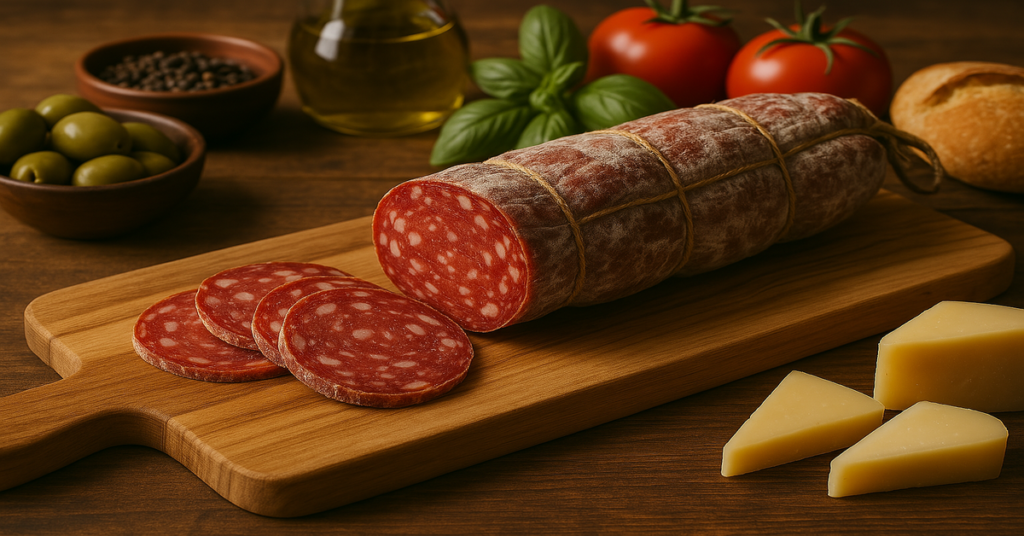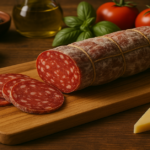Soppressata is more than just a cured meat—it’s a symbol of Italian culinary tradition, regional pride, and artisanal craftsmanship. Found on charcuterie boards, in rustic sandwiches, and at festive tables across Italy and beyond, soppressata is one of the most beloved types of salumi (Italian cold cuts). With its bold flavors, coarse texture, and deep historical roots, soppressata tells the story of rural Italy’s ingenuity and its love for hearty, preserved foods.
This article delves into everything you need to know about soppressata: from its origin and regional variations to how it’s made, served, and enjoyed today in both traditional and contemporary kitchens.
What Is Soppressata?
Defining Soppressata
Soppressata (sometimes spelled sopressata) is a dry-cured Italian salami traditionally made from coarsely ground pork, salt, spices, and sometimes red pepper flakes or wine. Unlike industrially processed salami, soppressata often has a rustic appearance, varying in shape and size depending on its region of origin.
The meat is stuffed into natural casings and then aged for several weeks to months, allowing its flavor to develop. Some versions are pressed during curing (hence the name, derived from soppressare, meaning “to press”).
A Culinary Heritage
Soppressata is not just food—it’s heritage. Often homemade in small villages, especially in Southern Italy, families passed down recipes for generations, tailoring them with locally available ingredients. Today, artisanal soppressata is revered for its authenticity and connection to Italy’s agricultural past.
Historical Background
Ancient Preservation Techniques
The roots of soppressata trace back to ancient times when preserving meat was essential for survival. Before refrigeration, Italian families relied on salt curing, drying, and fermenting to extend the shelf life of pork after the annual pig slaughter.
Rural Tradition
In regions like Calabria, Basilicata, Puglia, and Abruzzo, the making of soppressata was part of an important winter ritual. The “matanza”—a communal pig slaughter—was an event that brought families together to prepare various cuts and salumi.
Soppressata emerged as a way to make use of prized cuts like the shoulder, loin, and ham, ensuring that nothing from the pig went to waste.
Regional Varieties of Soppressata
Soppressata di Calabria (Calabrian Soppressata)
Calabria, located in southern Italy, is perhaps the most famous producer of soppressata. This variety is:
- Spicy, thanks to the generous use of Calabrian chili peppers
- Deep red in color
- DOP protected (Denominazione d’Origine Protetta), meaning it is regulated under EU guidelines
Calabrian soppressata is pressed between wooden boards for a flatter shape and hung for long aging periods in dry, cool environments.
Soppressata di Basilicata
This version is known for being:
- Coarser in texture
- Seasoned with fennel seeds, black pepper, and sometimes white wine
- Handmade using age-old techniques passed down in rural households
It’s traditionally served in thick slices with crusty bread and red wine.
Soppressata Toscana (Tuscan Soppressata)
Tuscany’s take on soppressata is completely different. Here, soppressata di testa (head cheese) refers to a type of cooked salami made from parts of the pig’s head, including tongue and cheek.
The meat is boiled, chopped, seasoned with garlic and herbs, and packed into molds to form a loaf. It’s sliced thin and often served cold.
Soppressata Veneta (Venetian Soppressata)
In Veneto, soppressata also refers to a cooked salami, typically made during winter from head meat and seasoned with salt, pepper, and lemon zest. It’s popular in northern regions and often eaten with polenta or pickled vegetables.
Ingredients and Flavor Profile
Base Ingredients
The core ingredients in most traditional soppressata recipes include:
- Pork (shoulder, leg, sometimes belly)
- Salt
- Black pepper
- Garlic
- Crushed red chili flakes (optional for spicy versions)
- Wine (white or red, depending on region)
- Natural casing (usually pig intestines)
Flavor Notes
Soppressata’s is:
- Robust and savory, with a balance of meatiness and spice
- Texturally coarse, due to the large meat grind
- Umami-rich, especially after months of aging
- Sometimes spicy, depending on the use of chili or pepper
The aging process intensifies the flavor, concentrating both the salt and natural sugars from fermentation.
How Soppressata Is Made
Step 1: Meat Selection and Preparation
High-quality pork is selected, ideally from heritage breeds. The meat is trimmed, coarsely ground, and mixed with spices, salt, and sometimes wine. No artificial additives are used in traditional recipes.
Step 2: Stuffing and Tying
The seasoned mixture is stuffed into natural casings, usually by hand. The casings are tied with string at intervals, often giving the soppressata’s its signature plump, rustic appearance.
Step 3: Pressing (Optional)
Some southern varieties are pressed between wooden boards to flatten the salami slightly. This technique aids in moisture removal and enhances the cured meat’s texture.
Step 4: Fermentation and Aging
The sausages are hung in cool, humid cellars or curing rooms for anywhere from 30 days to several months. During this time:
- Lactic acid bacteria ferment the sugars
- Mold may develop on the casing, protecting the meat and contributing to flavor
- The soppressata’s dries and hardens, developing its unique aroma and taste
How to Eat and Serve Soppressata
As Part of a Charcuterie Board
Soppressata’s is a staple on antipasto platters, paired with:
- Cheese (like Pecorino or Parmigiano-Reggiano)
- Olives
- Roasted red peppers
- Crusty Italian bread
- Red wine
Its bold flavors complement creamy cheeses and acidic accompaniments.
In Sandwiches and Panini
Layered with mozzarella, tomato, arugula, or roasted vegetables, soppressata’s makes for an exceptional sandwich filling.
Cooking With Soppressata
While traditionally served raw, soppressata’s can also enhance dishes such as:
- Pasta sauces
- Frittatas
- Flatbreads or pizzas
- Baked dishes for a spicy, meaty kick
Nutritional Information
Macronutrients (Per 1 oz / 28g)
| Component | Approximate Amount |
|---|---|
| Calories | 120–150 kcal |
| Protein | 6–8g |
| Fat | 10–13g |
| Carbohydrates | <1g |
| Sodium | 400–600 mg |
Health Considerations
Soppressata’s is high in sodium and saturated fats, so moderation is key. Opting for artisanal or nitrate-free versions can help reduce processed additive intake.
It’s naturally low-carb and high-protein, making it popular among keto and paleo diets.
Storing and Handling Soppressata
Whole vs. Sliced
- Whole soppressata’s (uncut) can be stored at room temperature in a cool, dry place for several weeks or months.
- Sliced soppressata’s should be refrigerated and consumed within a week for best flavor.
Mold and Bloom
White mold on the casing is normal and can be wiped off before serving. Avoid soppressata’s with green, black, or fuzzy mold, which may indicate spoilage.
Buying and Selecting Quality Soppressata
Artisanal vs. Commercial
Artisanal soppressatas is handmade, often from pasture-raised pork, with minimal additives. It offers:
- Superior texture
- Deep, natural flavor
- A connection to tradition
Commercial brands are widely available but may contain preservatives, colorings, or lower-grade meat.
What to Look For
- Firm but not rock-hard texture
- Deep red color with visible fat marbling
- Natural casing (not plastic)
- No artificial shine or synthetic smell
Popular brands include Creminelli, Fra’ Mani, Volpi, and many local Italian butchers.
Cultural Significance and Celebrations
A Family Tradition
In many Italian households, soppressata’s-making is a seasonal ritual performed in winter. Families gather to prepare meat, tell stories, and pass on heritage—reminiscent of how wine or cheese is made.
Festivals and Fairs
In southern Italy, sagra festivals celebrate regional foods like soppressata’s. Towns in Calabria or Basilicata host tastings, cooking contests, and music-filled events where the salami is the star.
Soppressata Around the World
In the United States
Thanks to Italian immigration, soppressata’s is a staple in Italian-American cuisine. Cities like New York, Chicago, and Philadelphia have delis and markets where the meat is sold both fresh and aged.
In Canada and Australia
Italian communities in Toronto, Montreal, Melbourne, and Sydney also uphold the tradition, with family-run shops producing high-quality soppressata’s.
Conclusion
Soppressata’s is a shining example of how food can connect people across time, geography, and generations. What started as a preservation necessity in rural Italy has blossomed into a cherished delicacy enjoyed worldwide.
Its bold flavor, rustic charm, and artisanal roots continue to make soppressata’s a beloved staple on tables everywhere. Whether you’re enjoying a slice from your grandmother’s pantry or from a gourmet charcuterie board, you’re tasting centuries of history and the essence of Italian culinary heritage.
FAQs
1. What’s the difference between soppressata and salami?
While both are cured pork products, soppressata is usually coarser in texture, more rustic, and often pressed or made by hand. Salami is a broader category and may be more finely ground and commercially made.
2. Is soppressata always spicy?
Not always. Calabrian versions are typically spicy due to red chili flakes, while Tuscan or northern varieties may be mild or herbaceous.
3. Can soppressata be eaten raw?
Yes, soppressata is dry-cured and fully safe to eat as-is. It’s typically sliced thin and served cold or at room temperature.
4. Is soppressata suitable for people on keto diets?
Yes, it’s low in carbohydrates and high in fat and protein. However, check for added sugars or preservatives in commercial versions.
5. How long does soppressata last?
Whole, properly cured soppressata can last several months in cool storage. Sliced soppressata should be refrigerated and consumed within a week.
6. What wine pairs well with soppressata?
Robust reds like Chianti, Barbera, or Zinfandel pair beautifully with the richness and spice of soppressata. For white wine lovers, try Verdicchio or Vermentino.







